How do I get started?
When SugarPal launches for the first time, enter your name, birthdate, sex and weight, and select your preferred blood sugar units. Enter an e-mail adress for your monthly data overviews, and leave all the other settings at their default value. Do not worry, there is no urgent need to change them now. Leave the "Expert" switch in the "off" position. You are now ready to enter your blood sugar values and insulin doses using the + buttons at the top right of the respective screen. The first reading that needs to be entered is your blood sugar right before your next breakfast. After, record all your insulin doses and blood sugar readings at the moment they occur for a few days, and observe how the blood sugar and insulin screens fill themselves with your data. Make sure you have your iPhone always at hand, since it is difficult to enter results afterwards, and familiarize yourself with SugarPal. During this period, just take the insulin doses advised by your doctor, always select "update baseline", and do not worry about the dark gray blood sugar trend line. When, after a while, the insulin dose and blood sugar level predictions start to make sense, and you have gained some experience with SugarPal, it is time to personalize your blood sugar correction factor and carbohydrate ratio. Consult the built-in help (i) and the support page of this web site for detailed instructions on this. Adjust these parameters in small steps and take your time to evaluate their effect.
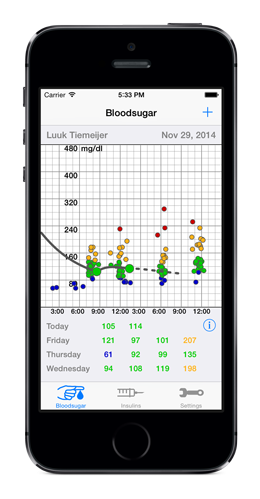
What's on the blood sugar screen?
- On the top right of the screen you will find the + button to enter the result of a new blood sugar measurement. You need to enter at least one blood sugar reading before a new insulin dose can be calculated.
- Just below, you will find your name and the current date. When the blood sugar screen is tapped, this text is replaced with an average of your recent blood sugar readings. The type of average depends on where the screen is tapped.
- Further below, you will find a graph of your blood sugar readings over the day. The little dots are from the past weeks. The larger dots are from today. The graph shifts over time to keep the most recent result approximately in the center of the screen. This graph can be used for a quick assessment of the spread in your recent blood sugar results and to discover systematic variations over the day.
- The blood glucose levels are indicated with colors. A green color is used for a blood glucose level within 20 % of the target value. A blue color is used when it is more than 20 % below, yellow when it is more than 20% above, and a red color is used when it is more than 80 % above your blood glucose target value.
- The dark gray line reflects your blood sugar trend. The dashed part is the prediction calculated by SugarPal based on your last blood sugar reading and the recently injected amounts of insulin.
- At the bottom, you will find a short overview of the blood sugar values you entered recently. When a fairly low blood sugar reading is entered, here an estimation is given about the amount of extra carbs that might be needed.
- On the lower right, you will find the (i) button which gives access to instructions on how to use the app. Compared to the explanations offered here on the web site, they are more condensed. In the "expert" mode the (i) button gives access to the insulin baseline values, as calculated by the app. They can be inspected and modified here.
- Furthermore, in the "expert" mode, an "organize " button is provided at the top left of the screen which allows you to modify incorrectly entered blood sugar readings.
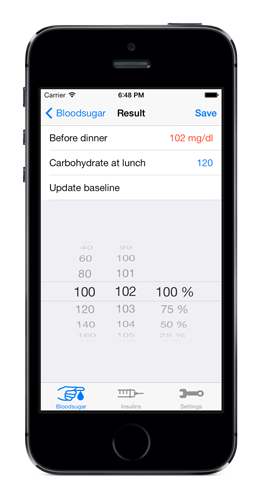
How do I enter a blood sugar value?
- Tap the + button in the blood sugar screen to enter the blood sugar result entry screen.
- SugarPal indicates whether a blood glucose reading before breakfast, lunch, diner, or before the night is expected. Check whether this is correct. If not, you might have forgotten one of your insulin injections, and you might need to consult your doctor first.
- To enable SugarPal to calculate a meaningful insulin dose advice, you should measure your blood sugar level at least once before each insulin injection.
- After the blood sugar result entry screen has opened, SugarPal presents its expected blood sugar value in the top row. All you need to do is replace this by the value that you just measured using the left and center picker wheels.
- In the middle row, SugarPal shows the amount of carbohydrates you have eaten at the previous meal. This can be your default value, as taken from your settings, or a value you have entered by carefully counting the carbs in your last meal. This value includes the carbohydrates from your last snack.
- In the bottom row, SugarPal shows what will happen after saving the blood glucose reading you just have entered. These actions can be controlled through the right picker wheel.
- Your blood glucose reading is easily entered by turning the left picker wheel first for a course adjustment and then using the center picker wheel for the fine adjustment. Check whether the text in the top row is adjusted accordingly.
- When your blood glucose reading disagrees with your and/or SugarPal's expectations you need to consider the possible causes. If you are pretty sure that you have consumed the amount of carbs indicated in the middle row, and you are not ill or have exercised excessively, it is best to leave the right picker wheel at 100 %. As a result SugarPal will adjust its baseline for the calculation of this insulin dose, in order to get a better result the next day. When, on the other hand, there is a clear explanation for a deviant blood glucose reading, and it would be better to keep the insulin baseline, this can be indicated by turning the right picker wheel to 0%. SugarPal then assumes that you have consumed either a bit more or somewhat less carbs, and adjusts the text displayed on the middle row accordingly. When you are in doubt, you can select an in between value.
- The save button is located at the top right of the screen. Use this to confirm the value you have just entered. The button located at the top left returns you to the blood sugar screen without saving anything.
- When a blood sugar reading has been entered, to prevent mistakes, you need to wait 3 minutes before the next reading can be entered.
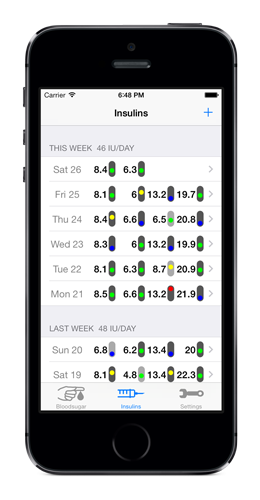
What's on the insulins screen?
- On the top right of the screen you will find the + button to instruct SugarPal to calculate and register the dose for a new insulin injection.
- Just below, your recent insulin doses and their impact on your blood glucose levels are displayed.
- Each row contains the data for one day. Following the date, (in blue), the four black figures represent your three doses of short acting insulin and your dose of long acting insulin.
- Each row of four “traffic lights” gives you a quick indication of how well these doses of insulin helped you to achieve your target blood glucose values afterwards. When the light is green, your blood glucose was within 20 % of the target value. Blue indicates that it was more than 20 % below, yellow indicates more than 20 % above, while a red light is given when you entered a blood glucose value more than 80 % above your target value. A light gray background indicates that your insulin units were adapted because you planned physical exercise. You are doing well if you get a fair amount of green lights, some yellow and blue, and only a few occasional red lights.
- The rows are grouped into blocks of one week each. For each block the average amount of insulin units taken each day is indicated. This amount may vary over the weeks.
- The arrow on the left reveals additional details for that particular day.
- Scrolling down, past data up to one year back can be inspected, enabling you to check out blood glucose profiles on any day that could interest you, and discover hidden patterns in your blood glucose values or in your insulin needs.
- In the "expert" mode, an "organize " button is provided at the top left of the screen which allows you to modify incorrectly entered insulin doses.
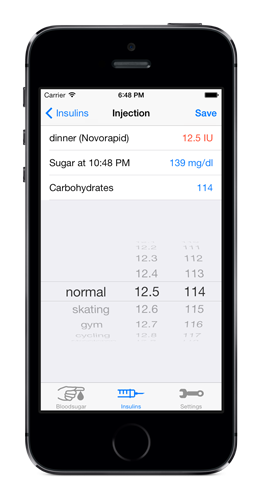
How do I calculate and enter the dose for a new insulin injection?
- Tap the + button in the insulins screen to enter the insulin injection screen.
- SugarPal now indicates whether your insulin injection before breakfast, lunch, diner, or before the night is expected. Check whether this is correct. If not, you might have forgotten one of your insulin injections, and you might need to consult your doctor first.
- After the injection screen has opened, SugarPal shows its calculated insulin dose advice in the top row. Only follow this advice when you have used the app for some time, you have familiarized yourself with SugarPal, and the suggested dose falls within the range agreed upon with your doctor or diabetes care provider. When in doubt stick to the dose agreed up on with your doctor.
- By turning the center picker wheel you can set the insulin dose to the value agreed up on with your doctor.
- In the center row, SugarPal shows what your blood glucose value could become as a result of the insulin dose you selected with center picker wheel. In the first days of use the app has to adjust itself, and it is better not to pay too much attention to these expected blood glucose figures.
- By turning the left picker wheel you can indicate that you want to practice one of your favorite sports. You will automatically get a dedicated dose advice.
- The right picker wheel is only shown when the "Carbs" option has been activated in the settings. By turning this wheel, you can assure that the suggested insulin dose is tuned to the amount of carbs you intend to eat the indicated meal.
- In the bottom row, SugarPal provides a short summary of the selected adjustments for the calculation of your insulin dose.
- When you are ready to inject the insulin dose indicated in the top row, save this dose using the button located at the top right of the screen. The button located at the top left will bring you back to the insulin screen without saving anything.
- When a new insulin dose has been entered, to prevent mistakes, you need to wait 30 minutes before a blood glucose reading can be entered.
Why is the insulin dose calculated in tenths of units?
SugarPal uses tenths of insulin units to give the right advice even for users with a high insulin sensitivity. When you are using an insulin pen that only allows you to dose in whole units of insulin, from time to time you will need to adjust the amount of carbohydrates in the meal a bit to be able to get to the desired blood sugar level with a rounded insulin dose.
Do I need to count carbs when using SugarPal?
It depends, if you, like me, take pretty much the same amount of carbs every meal, you can leave the “carbs” switch in the off state, which hides the option to adjust the amount of carbs before every meal in the insulin injection screen. This can be very handy, and will safe you some time. On the other hand, if you are already used to counting your carbs exactly, it is better to enable the option to take these into account when calculating your insulin dose.
Can I skip or add a meal?
In the past 20 years, I have noticed that keeping a certain daily routine, when its comes to meal intake and activities, makes it easier to control my blood glucose values. That is why the three meals can be shifted in time, as needed in the weekends, and can be changed in carbohydrate content, but can not be skipped entirely. Basically, all food taken during the day is assumed to be part of one of the three meals. As a result, the carbohydrates of any in between snacks should be added to those of the previous meal.
If you live a fairly regular live, SugarPal can help you optimize your insulin dose based on the results obtained on previous days, and probably few additional blood glucose measurements will be needed. If this is not your thing, you may need to look further for a diabetes management scheme that provides more flexibility.
When should I do an additional blood glucose measurement?
If you suspect that your blood glucose is too low, you must do an additional measurement to verify this. When recording the result, leave the right picker wheel of the input screen at 100 % to have SugarPal adjust its baseline for the calculation of the last insulin dose, in order to get a better value the next day. When the blood glucose level just entered is more than 30% below your target, an estimation of the amount of carbs needed to fix this "hypo" is given. If you're not ready yet for a next meal, take an appropriate snack. Then enter a new blood glucose result just before your next insulin injection, this time turning the right picker wheel of the input screen to 0 %, to let SugarPal estimate the extra carbs taken. After, the dose for a new insulin injection can be calculated the usual way.
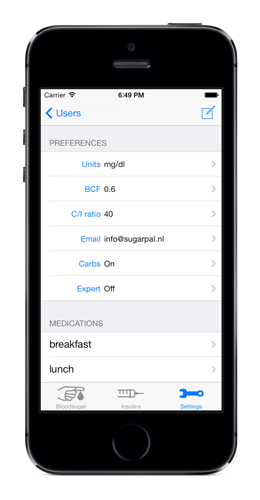
What's all there on the settings screen?
- At the top left of the screen you will find a button to switch users and/or create an additional user. This is an option you may want to experiment with, but will most likely rarely need.
- At the top right of the screen you will find the email button. This makes you an email backup over a recent period. This button only works when an email account has been created on your iPhone, and a default email address has been set.
- You can scroll through the settings screen. From top to bottom you will find subsequently:
- Name: Your name as it will appear on the blood sugar screen.
- ---General---
- Birthdate: Your birth date.
- Sex: Male or Female.
- Age: Is calculated for you.
- Weight: Your weight.
- ---Preferences---
- Units: This is where you select whether you want to record your blood glucose levels in mmol/l or in mg/dl.
- BCF: Your blood sugar correction factor. It is recommended to use SugarPal for a few days before adjusting this factor and only make adjustments in small steps.
- C/I ratio: Your carbs to insulin ratio. This ratio is the same for all meals. Also here there is no urgent need for immediate adjustments.
- Email: When you provide an email address here, SugarPal will sent you monthly overviews of your data.
- Carbs: Activates the option to enter the exact amount of carbs taken at each meal, and take this into account for the insulin dose calculations.
- Expert: Activates the option to adjust additional settings. For normal use this switch should be in the "off" position.
- ---Medications---
- Here, in the details screens for the insulin injections to be taken at breakfast, lunch, dinner, and night, some important details can be set.
- Name: (short) name of the time of day for this insulin dose.
- Insulin: name of the insulin.
- ---Parameters---
- Target: Your blood glucose target before your next planned insulin injection.
- After: Expected time until your next planned insulin injection.
- Active: The acting time of this insulin. Use different values for your short-acting and long-acting insulins.
- Offset: (Only visible in expert mode) This is the difference (in seconds) between the insulin acting time and the time needed for your meal to digest. This setting allows you to further customize the shape of the predicted blood glucose curve. This is something that you may want to experiment with in due time, but unless you are wearing a continuous glucose monitor (CGM), this setting is probably best left to zero.
- ---Carbohydrates---
- Normal: The amount of carbs usually taken for this type of meal.
- Extra: (Only visible in expert mode) The extra carbs you have added the to this meal the last time you took it.
- Fitted: (Only visible in expert mode) The extra carbs SugarPal has added to this meal as a result of your last blood glucose reading.
- ---Sports---
- Add New...: This is where you can set and manage the insulin dose corrections needed for physical exercise.
- Here, in the corresponding details screens, you can check and edit the dose corrections for each type of sport you want to practice on a regular base.
- Name: name of the sport.
- ---Corrections---
- Morning: Insulin dose correction factor when this sport is practiced after breakfast.
- Afternoon: Insulin dose correction factor when this sport is practiced after lunch.
- Evening: Insulin dose correction factor when this sport is practiced after dinner.
- Updated: The last time you practiced this sport and updated one of its correction factors.
- ---More settings---
- Sugar days: The number of days for which results and averages are displayed in the blood sugar screen.
- Plot days: The number of days for which the insulin baselines and blood sugar statistics are displayed. This number can also be set by swiping the insulin baselines and blood sugar statistics graphs.
- Max insulin: The maximum insulin value displayed in the insulin baselines graph.
- Maildate: Date your last manual email backup has been sent.
- Status: Tracks the order of your meals and insulin doses. Updates automatically. Adjustments not needed.
What should I use for the carbohydrate ratio and blood glucose correction factor?
The values of these factors can vary considerably from person to person. They depend, among other things, on your weight and your insulin sensitivity. A recommendation is given here. First familiarize yourself with SugarPal for a few days using the default values. Then adjust these parameters in small steps and take your time to evaluate their effects.
What blood glucose target values should I be using?
The glucose target values chosen by the program are generally accepted as a good starting point. They should be adjusted if you think they do not bring the desired results.
What should I do if I want to work out?
If you start exercising intensely, you will need less insulin. In particular, if you keep the amount of carbs in your meal the same. SugarPal Diabetes Manager can calculate for you how much you can reduce your usual dose of insulin. For this, SugarPal will keep track of three dose reduction factors. You must first add this specific activity in the list of sports and then select it before calculating the meal insulin. SugarPal can only calculate a proper insulin dose reduction if you practice this sport regularly, and each time with an approximate similar intensity. Be prepared that, when a new sport is practiced for the first time, the proposed insulin dose reduction will most likely not yet result in the desired blood glucose levels.
If you start exercising regularly, for instance to loose some weight, your insulin baselines may drop as well. Provided you let SugarPal adjust its baselines for the calculation of the insulin doses after each suitable blood glucose measurement, this will be accounted for automatically, and all your calculated insulin doses will follow the downward trend.
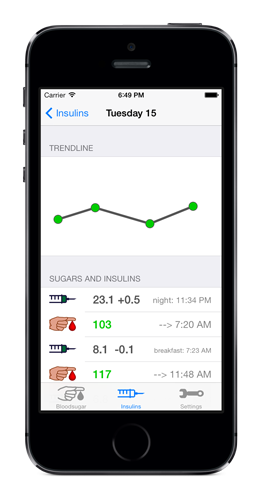
How can I view my daily data?
- Tap in the insulins screen on the row with the date for which you want to see your data. You will enter the day diary.
- When multiple blood glucose readings are available, a small blood sugar graph is presented at the top of the screen.
- The blood glucose levels are indicated with colors. A green color is used for a blood glucose level within 20 % of the target value. A blue color is used when it is more than 20 % below, yellow when it is more than 20% above, and a red color is used when it is more than 80 % above your blood glucose target value.
- Below, you will find a list of the insulin units taken and the measured blood glucose values. The blood glucose values are indicated with the usual colors. Grayed out insulin units indicate that they were adjusted to account for exercise.
- Two figures are shown for the insulin units. The first figure is the actual injected dose. The second figure is the correction with respect to the baseline value of that particular day.
- You cannot edit any data in this screen.
Why can't I add additional comments?
This option is unfortunately not available. You can use your favorite carb counter application, any former diabetes diary application you might own, or use the default Notes or Calendar application instead.
Why is a built-in carbs counter not included in SugarPal ?
A number of good carbohydrate counter applications are currently available in the app Store. Some of them, like the english Carbs & Cals are especially intended for use by diabetics. If you prefer not to rely on rules of thumb and/or product information, they can be very helpful to establish the amount of carbs in your meals accurately. It can therefore be useful to install one of these applications in addition to the SugarPal Diabetes Manager application.
Why can't SugarPal calculate HbA1c values for me?
Most blood glucose meters for home use have an error margin of about 15% due to the small amount of blood tested. This accuracy is sufficient to regulate the blood sugar levels in a meaningful way. However, this would lead to incorrect results if these measurements were used to determine a HbA1c value. Based on the provided blood glucose measurements, SugarPal Diabetes Manager calculates a median and 10% and 90% cdf values. When you enter your blood sugar in mmol/l the median value is a reasonable estimate of the expected HbA1c value in %.
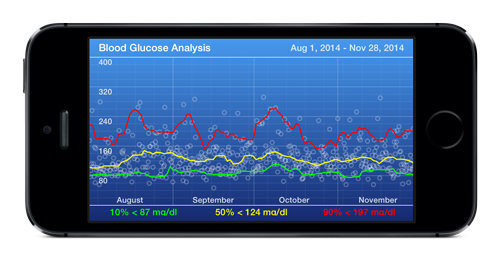
What is the purpose of the blood glucose analysis screen?
The blood glucose analysis screen becomes available when measurements have been entered for at least 10 days, and is aimed to provide an overview of the long term trends in your blood sugar results. However, when the blood glucose results collected over a period of months, would be shown as a cloud of discrete points, just as in the blood sugar screen, this graph would not be very insightful. Therefore, the individual measurements are analyzed first, before a graph is created. For this, all blood measurements taken over a period of one week are collected, and then sorted by ascending height. After, SugarPal runs along this row with graded blood glucose levels, and records representative values as respectively 10%, 50% and 90% of the measurements have been viewed. This is done for each series of seven consecutive days, and the values thus obtained are plotted in green, yellow and red in the blood sugar chart. Moreover, their averages are calculated. In the above example one can see at a glance that 80% of the glucose levels in the past period was between 87 and 197 mg/dl. Furthermore, half of the blood sugar levels have been lower than 124 mg/dl. Periods when the blood sugar levels were significantly higher or lower are easily recognizable. This analysis takes into account the original time between consecutive blood glucose measurements, and therefore the result is hardly distorted when a few extra deviant blood sugar results measured in rapid succession are entered.
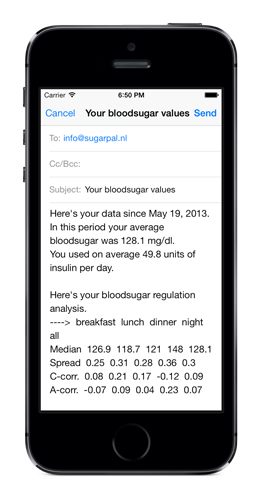
How can I transfer my blood sugar values to my computer or send them to my doctor ?
If you have entered an email account on your iPhone and provided an email address for yourself or for your doctor in the "Settings" tab, the app will create an email with a statement of your measurements in "CSV" format every month automatically. Alternatively, the email button from the "Settings" tab creates a similar mail with the data since your last "Maildate". The simplest way to share your data, however, is to rotate your iPhone either clockwise or counter-clockwise and take a screen shot. With the screen you want to share displayed, hold down the iPhone home button and press the power button briefly. The screen shot will be saved to your camera roll and you can print or email it from there.
What is glycemic control analysis?
The goal of diabetes treatment is to avoid diabetes complications by keeping HbA1c levels low. At the same time, it is desirable to avoid hypoglycemia as much as possible. At every email backup SugarPal therefore makes a glycemic control analysis.
Since fluctuating blood sugar levels can be described with a lognormal distribution, you will find the median values calculated from the geometric mean of the blood glucose levels before breakfast, lunch, dinner, night, and all together in the first line. In the second line you will find the spreads in the blood glucose values, calculated by the dividing blood sugar standard deviation by its median. The smaller this number, the better. In the third line, you will find the cross-correlation coefficients with the immediately preceding blood sugar readings. In the fourth line, you will find auto correlation coefficients with the previous measurements of the same type. These correlation coefficients indicate whether you have used a too large or a too small blood sugar correction factor. Positive correlation coefficients imply that your blood glucose fluctuations are not sufficiently corrected for, and you should set a somewhat larger blood glucose correction factor. Negative correlation coefficients indicate that your blood glucose fluctuations are generally overcorrected, and you would be better off using a smaller blood glucose correction factor.
A period of one month may be a bit short to get a good picture of your glycemic control. If you are considering to adjust your blood sugar correction factor it might be useful to also analyze a longer period of time.
What can I do best when I forget an insulin injection?
Suppose you discover, after measuring your blood sugar before dinner, that you forget to inject your insulin for lunch. Before lunch, you had a rather low blood sugar, and decided, this time, to eat first before taking your insulin. And then after lunch you simply forget to take the insulin. It is not so easy to tell what to do best now. You may need to consult your doctor first. What you should not do in any case, is inject the full lunch dose now. Very likely your remaining beta cells have done all their best to keep the rise of your blood sugar under control. If you inject your afternoon and your evening dose together now, your blood sugar will drop far too much.
My advice is this. First enter the missing insulin dose in SugarPal. Use a fictive dose that would provide the blood sugar you measured before dinner. In this case however, your remaining beta cells have actually provided this amount of insulin. Then you should change the timestamp of this insulin dose to the time when you took your lunch. To do so, enable the Expert mode and press the Organize button on the top left of the insulins screen. The upper record is the latest injected insulin dose. Enter into this record and adjust the time to when you took your lunch. Do not forget to save the adjustments and disable the Expert mode again. After, enter the blood sugar value you measured before dinner. In the blood sugar result entry screen make sure the baseline for the calculation of the lunch insulin dose is not adjusted, by turning the right picker wheel to 0%. Finally, you can enter the insulin dosage for dinner. SugarPal will now make sure that some extra insulin is added to correct your probably way too high blood sugar.
When you already discover that you have forgotten your insulin injection much earlier, because you do not feel so good anymore, it may be desirable to inject at least part of the missed insulin. Be aware of your possible enhanced activity of your remaining beta cells and measure your blood sugar regularly to avoid over correction of your blood sugar disorder. Again use the expert mode to adjust the time of the missed insulin injection and make sure when entering the extra blood sugar measurements that the baseline for the calculation of the lunch insulin dose is not adjusted.
How do I get my blood sugar data back if I lose my iPhone?
After you have purchased a replacement iPhone you can restore your data with a backup from iCloud or from your computer. You can then use the expert mode to add any missing blood-sugar or insulin values. You can also skip this, perform a new blood-sugar measurement and continue where you left off. If, for whatever reason, a proper backup is not available there is still no need to start from scratch since you can consult your most recent SugarPal email backup for the values of your personal settings.
Will there be Android or other OS versions?
Due to limited resources there are currently no plans in this direction.